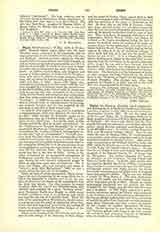

Digby, SIR KENELM, physicist, naval commander, and diplomatist, b. at Gayhurst (Goathurst), Buckinghamshire, England, July 11, 1603; d. in Covent Garden, Westminster, June 11, 1665. He was the eldest son of Sir Everard Digby, Kt., of Drystoke, Rutland, by Mary, daughter and coheir of William Mulshaw (Mulsho) of Gayhurst. His father was drawn into the Gun-powder Plot and was executed; nevertheless, after litigation, young Kenelm inherited unconfiscated lands worth $15,000 a year. In 1618 he entered Gloucester Hall, now Worcester College, Oxford. Here he was under the care of Thomas Allen, the mathematician and occultist, under whose congenial teaching he made wonderful progress in physical science. Allen eventually bequeathed to his brilliant pupil his books and MSS., which Sir Kenelm gave to the Bodleian Library. In 1620, Digby left Oxford without a degree. By this time he was deeply in love with Venitia, the beautiful daughter of Sir Edward Stanley, Kt., of Tonge Castle, Shropshire. His mother opposing the match, he withdrew to the Continent, visiting France and Italy and finally Spain. In March, 1623, shortly after his arrival at Madrid, the Prince of Wales (afterwards King Charles I) reached that city upon his well-known matrimonial project, and Digby became one of his household, accompanying the prince back to England upon that project’s failure. Digby was now dubbed a knight by King James I. The next momentous event in his career was his marriage with Venitia, which took place privily in 1625. Though the lady’s ante-nuptial reputation was not spotless, yet their conjugal life was happy, and she bore him four sons and a daughter. In 1627 Digby undertook a privateering expedition against the French ships anchored in the Venetian haven of Iskanderun or Alexandretta. Having got King Charles’s leave and taken out letters of marque, he sailed from Deal with two well-equipped ships about Christmas, and after various adventures on the voyage, he reached Iskanderun June 10, 1628. On the morrow he gave battle to the French and Venetian galleys there found in the bay, coming off victorious and returning leisurely to England, where he landed in the following February.
Digby’s fame was now great, and in 1632 there was even talk of his becoming a secretary of state, but misfortune was nigh. On May Day, 1633, his beloved wife, whose marriage with him had for some years been made public, died suddenly. Various poets, Ben Jonson and William Habington among them, put forth rapturous poems in her praise. Digby withdrew into Gresham College, where he spent two years, leading in strange mourning garb a life of study and seclusion. By this time he had forsaken the Catholic Church, to which, however, he was reconciled in 1636, apparently in France. In 1639 he was back in England, where the times were daily growing worse and worse. His intimacy as a Catholic with the king and queen roused the ire of the Long Parliament, who summoned him to their Bar in 1641, and next year imprisoned him. He was discharged, however, after a while, on condition of his immediate departure for France. His property they afterwards proceeded to confiscate. Digby accordingly transferred his abode to Paris, where in 1644 he brought out his two great philosophical treatises of the “Nature of (Windsor Castle) Bodies” and the “Immortality of Reasonable Souls”. In 1645 he was sent by the English Catholic Committee at Paris upon a diplomatic mission to Rome, whither he went again in 1647, but failed to accomplish anything to the purpose. After another journey to England in 1649 and another banishment, he got leave to return and came back in 1654. He now became intimate with Cromwell, who employed him abroad upon various diplomatic affairs. He returned to England for good at the Restoration Upon the incorporation of the Royal Society in 1663, Sir Kenelm was appointed one of the council. He died of stone on the anniversary of his sea-fight off Iskanderun, and was buried beside his wife in Christ Church, Newgate Van Dyck painted several (extant) portraits of Sir Kenelm and Lady Digby, and Cornelius Janssen one of the latter.
C. T. BOOTHMAN

